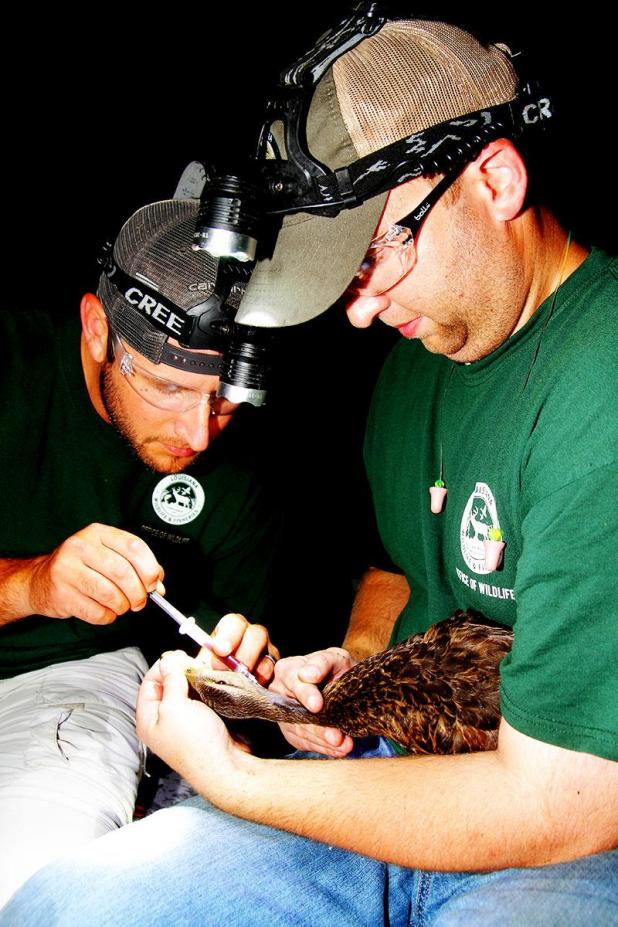
Louisiana Department of Wildlife and Fisheries biologists Joe Marty and James Whitaker draw blood from a captured mottled duck. (Submitted Photo/Courtesy of John K. Flores)
LDWF looks for answers with Duck Lead Study
Chance Baccacolopi swung the airboat around so fast, for an instant it was like being on one of those Tilta-Whirl carnival rides that comes into town for a festival weekend.
However, this ride wasn’t for fun. It was simply part of the capture process biologists often go through trying to catch mottled ducks at night during the hot, dog-day months of July and August on Rockefeller Wildlife Refuge.
Rockefeller is a 71,000-acre refuge along the southwest Louisiana Chenier plain in Cameron Parish. By description, the refuge serves as a test site for marsh strategies to limit saline encroachment, reverse marsh deterioration and provide wildlife habitat.
An estimated 160,000 waterfowl also winter on the refuge each year. And, it’s ground zero, where extensive banding has gone on that helps biologists determine survivorship and population densities of mottled ducks.
For a number of years now, it’s been widely documented that mottled duck populations have been declining on the Texas gulf coast, while they have remained somewhat stable in Louisiana.
According to a Texas study titled, “Blood L e a d E x p o s u r e Concentrations in Mottled Ducks on the Upper Texas Coast,” the primary cause for the downturn is human activity where the landscape has been altered and developed. The report states other causes also may include drought, saltwater intrusion, increased predator populations, exotic invasive plants and lead.
From studies conducted in the early 1970s, 1990s and early 2000s by these Texas researchers, mottled ducks continued to display increased lead concentrations in wingbone samples, though non-toxic shot regulations had been in place for decades. The report states before non-toxic shot rules, 33 percent of mottled ducks had eaten lead shot, as measured by its presence in gizzard samples.
When non-toxic shot was phased in from 1980-1983 on Texas’s coastal National Wildlife Refuges and public lands, the report says the ingestion rate fell to 17 percent and eventually 9 percent by 2002.
Since 2012, estimates for the upper Texas coast still range from 5 percent to 8 percent. What’s more, a rate double what’s normally found in other waterfowl species.
In 2017, Louisiana Department of Wildlife and Fisheries Biologist S u p e r v i s o r a n d Research Coordinator Joe Marty wanted to mirror on Rockefeller Wildlife Refuge a Texas study where biologists drew blood samples from mottled ducks looking for elevated lead concentration.
Explaining his motivation in conducting the mottled duck study, Marty said, “I really wanted to do a comparison to see if birds using Rockefeller had lower lead levels than birds off the refuge. But also, because mottled ducks aren’t doing that well right now. Their populations are declining. We have a number of theories and hypothesis, but it may have something to do with their breeding and nesting success. So, this study might just be another piece of the puzzle.” During July and August, typically when there is no moon or heavy cloud cover, mott l e d d u c k s o n Rockefeller are caught by using a sealed-beam headlight and airboat. The method of capture is extremely effective, with little to no mortality. Mottled ducks at this time of year are in their eclipse feather period and are flightless.
The cover of darkness, particularly with no moon, leaves them little ability to escape the surprise, speed and agility of an airboat with an experienced operator like Baccacolopi driving.
During the evening, it didn’t take long to catch a crate full of the near helpless mottled ducks. With two airboats working together, searching different parts of Rockefeller’s expansive marsh, before midnight our numbers were in the mid-twenties. On a good night with several boats working, the biologists have been known to catch closer to a 100.
L o u i s i a n a Department of Wildlife and Fisheries biologist James Whitaker works closely with Marty on various projects on Rockefeller, mottled ducks being one. It was Whitaker who did the c a t c h i n g , w h i l e Baccacolopi did the driving.
Whitaker says the department’s goal is to try and band 3,000 mottled ducks on public and private lands annually. Therefore, the biologist maintains, it only makes sense to test for lead exposure levels since the birds are going to be captured anyway.
Whitaker said, “This is information that hasn’t been collected in southwest Louisiana before. It’s inexpensive and taking blood samples is something we can do in house. The plus side is, we already have the birds in hand. I’m hoping optimistically, lead concentration levels are going to be extremely low on Rockefeller. But, it will be interesting to see what the study comes back with.”
This fall and winter, Marty and Whitaker also will be obtaining mottled duck gizzard samples from private duck clubs around the region.
One of the things the Texas report acknowledges is, if female mottled ducks are obtaining lead during the fall and winter, it could negatively impact female nesting potential, egg survival and brood success.
In time, Louisiana Department of Wildlife and Fisheries biologists will learn more from blood samples taken. Hopefully, lead concentration levels in Louisiana mottled duck populations will be negligible.
